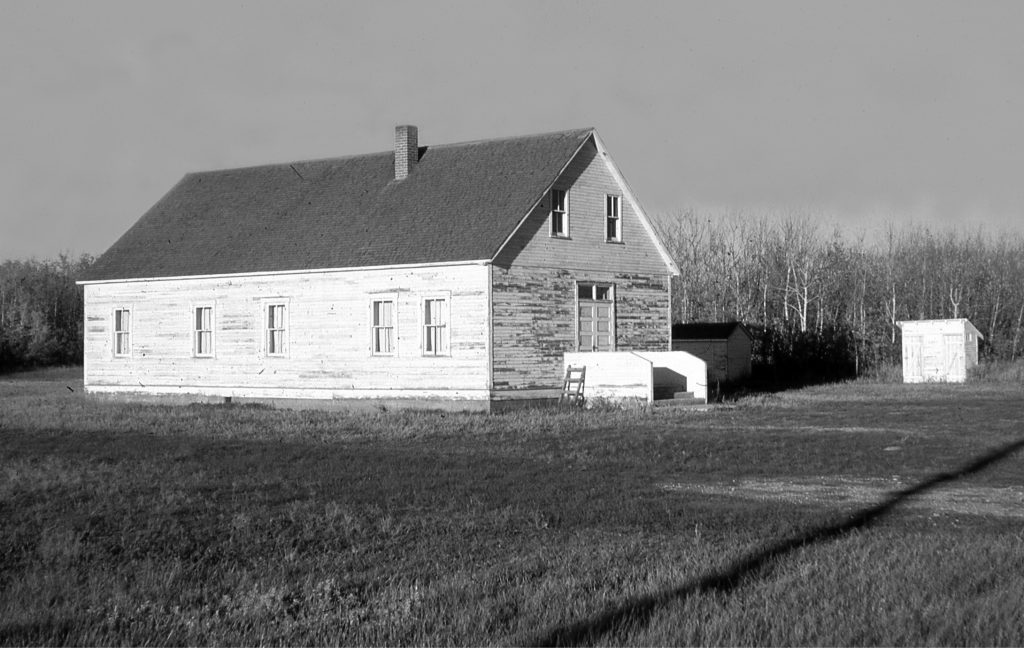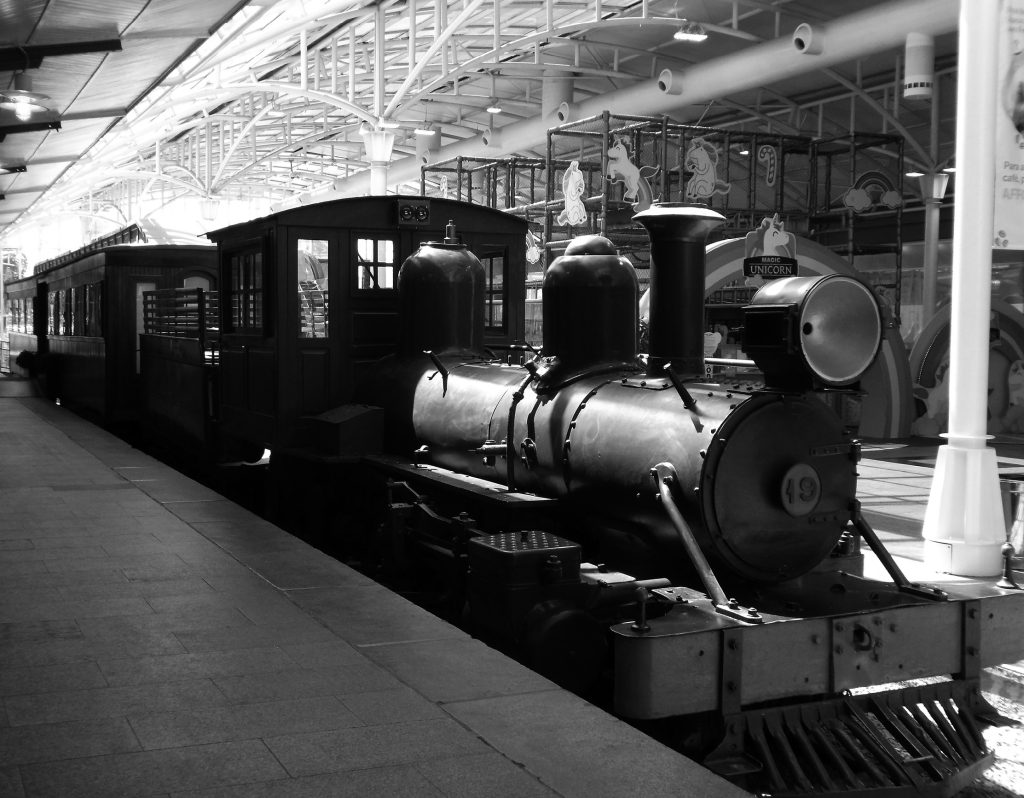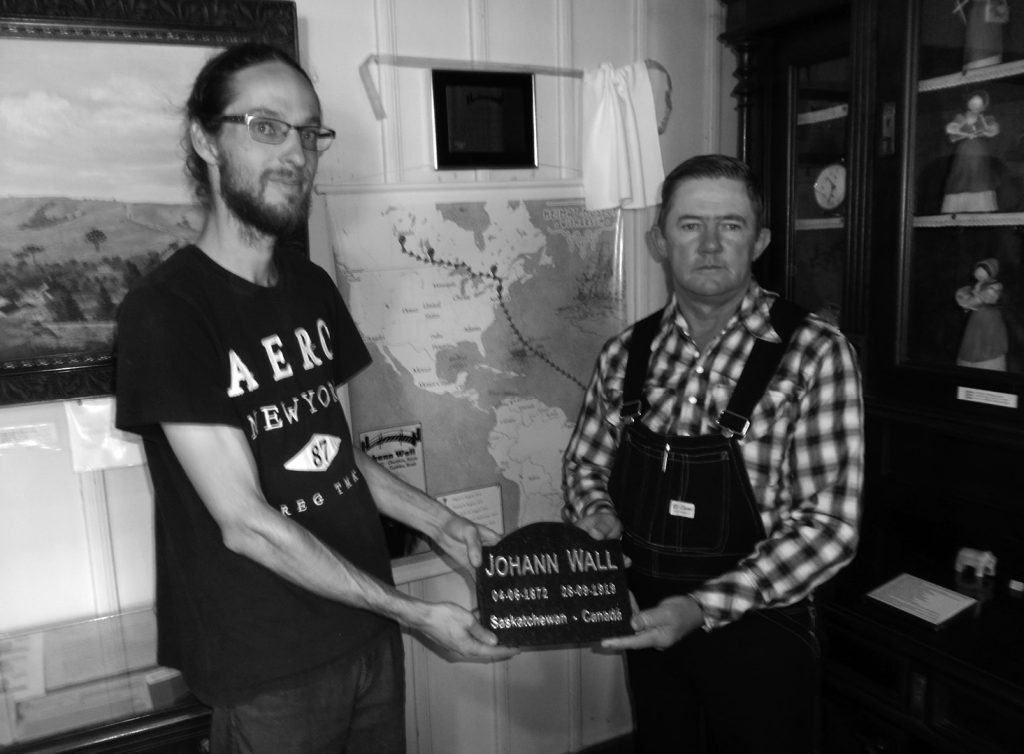Remembering Johann Wall in Brazil
Dick Braun
The commemoration of the death of Ohm Johann Wall started when Hans Kliewer, a retired schoolteacher from the Mennonite colony of Witmarsum, Brazil, emailed in 2018 with a simple question: “Do you know anything about the Johann Wall of Canada who died in Brazil?” I replied, “Yes, I do.” I had been involved in producing the book Hague-Osler Mennonite Reserve, 1895–1995, which touched on the story of Johann Wall’s trip to South America in 1919, as one of six delegates sent to South America in search of a new home. These men are believed to be the first Mennonites to set foot in South America, and Johann Wall, the first Mennonite to die there. It also happens that my wife and I live six kilometres from the village of Neuanlage, Saskatchewan, where the Walls lived when this story began. My exchange with Hans started a longer conversation by phone and email.
Johann (b. 1872) and Anna (Klassen) Wall (b. 1871) moved from Manitoba to Neuanlage in 1898. The Hague-Osler Mennonite Reserve was only three years old and life on the bald prairie was not easy. Many of the houses were dug into the ground with piled-up sod as walls. The roof rafters were made of poplar logs, hauled from across the South Saskatchewan River some five miles to the east, as there were no trees on the west side of the river. The roof could have been thatched with slough grass or maybe sod.

Things moved quickly for the Wall family, as within a few months of arriving in Neuanlage, Johann was voted in as a deacon of the Reinlaender Mennonite Church. In 1900 the decision was made to build the first church building in the village, which would have created a significant amount of work for the young deacon. Later that year Johann was elected into the ministry. The letter he wrote to his parents back in Manitoba reveals just how seriously he took this calling.
Records show that the Wall family fulfilled the requirements of the Homestead Act by constructing a home and planting crops. Life was progressing well for the family, but Mennonites began to encounter problems in their relationship with the government, especially during the First World War. The Manitoba and Saskatchewan governments legislated the teaching of school in English, in violation of the privilege of educational autonomy the Mennonites believed they had been guaranteed by the Canadian government in the migration negotiations of 1873. The heavy fines enforced by the provincial governments on families choosing not to send their children to English schools created huge hardships for conservative Mennonites. This education issue even forced Rev. Johann P. Wall to appear in court in Warman. Mennonites put considerable effort into trying to come to an agreement with the Saskatchewan government over the language issue, but to no avail. The conservative Mennonites felt that they had no choice but to look for a new home where they could live as they felt they were called to do.
This led to the decision of the Reinlaender Mennonite Church to send a delegation to South America to look for a new home. The delegates were Johann Wall and Johann P. Wall, from Neuanlage, Saskatchewan; Julius Wiebe and David Rempel, from Swift Current, Saskatchewan; and Klaus Heide and Cornelius Rempel of Manitoba. The men packed trunks, said goodbyes to family and friends, and boarded a train for Ottawa, where they received the proper paperwork for the journey. From Ottawa they travelled to New York, where they boarded a ship for South America. They visited Paraguay, Uruguay, Argentina, and Brazil, but nowhere could they make a suitable deal.
Then the unthinkable happened: Johann Wall became ill while they were in Curitiba, Brazil, and died a few days later.1 The diary of Johann P. Wall, as well as that of another delegate, tell of how they tried different remedies and called on a German-speaking doctor, who advised that he would need to operate on what was diagnosed as a burst appendix. It notes Wall’s time of death as 4:00 a.m. on September 28, and the details of his burial in a Lutheran cemetery in Curitiba, in grave number 1585.
Realizing that it would soon be the centenary of Wall’s death, Hans wondered if this event should be recognized in some way. Armed with the diary information, Hans began his research. He was able to locate the plot in the Curitiba Lutheran cemetery where Johann Wall was buried in 1919. Hans’s original idea was to place a proper marker on the burial site, but he learned that another family now owned the plot.
As I researched Witmarsum Colony, I noticed that they had a museum. I suggested to Hans that a marker could be set up there. Hans and the museum curator, Ricardo Philippsen, agreed to this idea and my suggestion that we commemorate the exact day when Ohm Johann Wall was laid to rest in Curitiba. Hans worked with people from the museum and others to set up a program.

On September 25, my wife Kathy and I arrived at the Curitiba airport, where we were picked up by Hans. A group of us wanted to get into the spirit of the event so we headed into the city, which is now home to three million people. Witmarsum Colony is about an hour’s drive from Curitiba. Our first stop was the old Curitiba train station, which is now a shopping mall containing a small museum, complete with a telegraph machine and an old steam engine. We were able to view the platforms where the Mennonite delegation would have arrived a hundred years ago. We even imagined that it was the telegraph machine that sent the news of Wall’s death to his wife in Saskatchewan. Historical records show that the men stayed at a nearby hotel, and indeed, across from the main doors of the former station is a hotel that is over a hundred years old.

Our next stop was the Lutheran cemetery. The diaries indicate that the delegation was able to purchase a plot to bury Johann Wall’s remains. We visited the plot with a little metal plate numbered 1585, but other names were inscribed on the headstone. We had been informed that the fees for the plot had been paid for some years, but that the plot was resold when the payment stopped. No one is quite sure who was paying, the Canadian government or the Reinlaender Mennonite Church or maybe the family.
On Saturday the Witmarsum Heimat-Museum held an event with the theme Bruecken Bauen, or “Building Bridges.” Heinz Egon Philippsen, a local historian, provided an overview of the Mennonite trek from the Netherlands and how some ended up in Brazil. Those of us gathered in the front parlour of the museum were a true picture of the event’s theme. In addition to my wife and I, there were local people and twenty-three members of the Wall family, including three grandchildren and some great-grandchildren who had travelled from Paraguay and Bolivia to take part in the event. The local organizers spontaneously asked the oldest grandchild attending – seventy-nine-year-old Jakob Wall of Durango Colony, Paraguay – to help curator Ricardo Philippsen unveil the plaque to commemorate Wall’s death. After a few more formal greetings, we were invited to browse the museum grounds and to visit.
In the early 1930s, Mennonite settlers started Witmarsum Colony in Brazil. The settlers had a hard time making a living in their original location. In 1951, Mennonite Central Committee helped them buy the land they occupy today. The 7,500 hectares had been a cattle ranch with one large manor house, some outbuildings, and a dam on the local river to produce all the electricity they needed. Initially the first families lived in the manor house. Later it became a hospital, and now it is the museum. They also built a new hospital, but turned it into a seniors home due to lack of use. Their large school has about six hundred students of which only about a third are Mennonites. It was of interest to us that even though the school operates in Portuguese, German is still taught as a second language. The colony has a number of large dairy farms, and a large co-operative store and a collection point for crops and milk. There is also a Mennonite who brews beer. It is a very progressive community.
A group of Ohm Johann Wall’s descendants from Durango Colony in Paraguay had brought their own plaque engraved with the dates of his birth and death, which they had hoped to mount at the gravesite. When they realized that this would not be possible, a discussion led to the decision to place it at the Witmarsum cemetery.

After the formal part of the afternoon we were all invited to the Kliewer house for faspa. Here we had more opportunity to visit and get to know each other better. We learned that some of the Wall descendants are Walls on both sides. When the 1919 delegates returned home, the wife of Ohm Johann P. Wall died, and he married the widow of Johann Wall. When some of those children married, it led to “double Walls”! We also heard that more people from Mexico and Canada might have attended the event had they heard about it a little sooner. We spoke to one Wall descendant who is helping a colony teacher gather information on the Old Colony Mennonites before their move to Mexico, a story that many of their people know little about.
The evening program held at the Evangelical Mennonite Church started with some music by a local women’s group. Both the pastor of the Evangelical Free Church and the Mennonite Brethren Church spoke briefly on the theme “God is the master bridge builder.” Werner Braun told the story of the Mennonites’ European trek before their move to Mexico. I gave a brief overview of Ohm Johann Wall’s life and on the situation in Neuanlage, Saskatchewan, in 1919. We know that the house that Johann and Anna Wall lived in was later moved to the Kronstal area to be an Old Colony church, and then moved to Martensville as a church, and then back again to the village of Neuanlage to be a church for the Church of God and Christ, Mennonite (Holdeman). Today it is a personal residence and, interestingly, a distant relative of Johann Wall is living in it. I brought letters of greetings from the Mennonite Historical Society of Saskatchewan and from the Old Colony Mennonite Church of Saskatchewan, thanking the people in Witmarsum for their work in preserving Mennonite history. I touched on the reason the delegation to South America was looking for a new home.
Next, Hans Kliewer asked those attending to imagine what it was like for those men in the delegation to leave their families and travel all the way to Brazil. He explained how diaries written by the men describe many things, including their twenty-nine-hour journey by train to Curitiba. This was followed by a presentation from the local organizers. I received a plaque just like the one unveiled in their museum, and members of the Wall family were given maps showing the trek the delegates took to get to South America. The evening wrapped up with more visiting.
The local organizers and especially Hans Kliewer were very excited that the celebration turned out to be so well attended by their local people, who were mostly unaware of the early Mennonite presence in Brazil. They were also very pleased by the number of descendants of the Wall family who travelled great distances to attend. A highlight for me was definitely the attendance of Wall’s grandson, Jakob Wall, who helped with the unveiling of the plaque.2
- A translation of the letter Johann P. Wall sent to Johann Wall’s widow can be found in Preservings, no. 29 (2009): 24–25 ↩︎
- I want to thank the people of Colony Witmarsum and especially Hans Kliewer for all the work that went into making the event so meaningful and such a success. I want to thank the Wall family members that travelled a long distance and took the time to attend. I especially want to thank the D. F. Plett Historical Research Foundation for sponsoring me to attend the event. I found it humbling to represent the Mennonites of Saskatchewan and Canada. ↩︎
